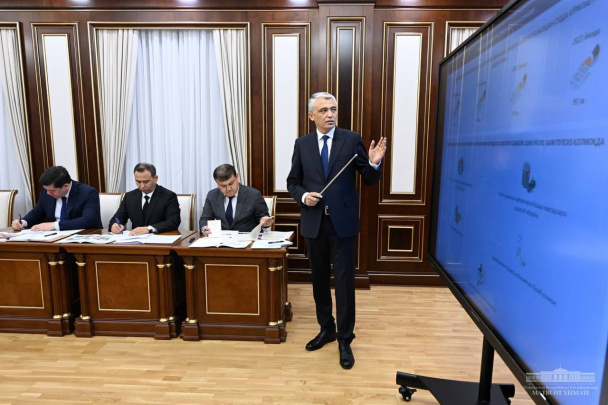Tashkent’s long-awaited master plan approved

Photo: Kun.uz
A decision by the Cabinet of Ministers regarding the approval of the master plan for Tashkent city for the period until 2045 has been published.
The decision outlines that the aim of the master plan is to ensure the complex development of Tashkent city, improve the quality and level of construction planning, and enhance the city’s architectural and urban planning appearance, as well as its infrastructure.
The main indicators of the master plan will be published as open data in the urban planning cadastral geo-information system of the Ministry of Construction and Housing and Communal Services.
Any construction activities will be carried out based on the approved master plan, following the established procedure, with the development of the master plan, detailed planning project, or construction project for the respective area, to be approved.
The progress of the implementation of the master plan will be reported by the governor of Tashkent at quarterly meetings of the Cabinet of Ministers.
The primary goal of developing the master plan is:
- To regulate the construction permit process;
- To plan the city’s engineering and road-transport infrastructure, population density parameters, and general strategy;
- To protect the city's green and sanitary protected areas, as well as its cultural heritage;
- To define economic and social development pathways;
- To meet the current and future needs of the population.
Special attention in the master plan is given to addressing the following issues:
- Zoning of Tashkent’s territories;
- Meeting the demand for population movement and ensuring the stability of transport flows;
- Establishing urban planning requirements to ensure the stability of the city’s density parameters.
In accordance with the presidential decree of September 11, 2023, a simplified version of the master plans for cities is permitted.
The simplified version of the master plan divides Tashkent into the following zones:
- Conservation zones
- Reconstruction zones
- Renovation zones
In conservation zones, cultural heritage buildings, historical sites, houses, and green areas will remain unchanged. Construction of additional residential and non-residential buildings and structures will be prohibited in these zones. In reconstruction zones, additional constructions can be carried out based on master plans. In renovation zones, new buildings and repairs will be carried out in place of outdated housing and buildings.
The document specifies that the Tashkent city administration is to develop a comprehensive action plan for the implementation of the master plan by 2045 within three months, coordinating with relevant ministries and agencies before submitting it to the Cabinet of Ministers for approval.
The Ministry of Construction and Housing and Communal Services will conduct state architectural control to ensure compliance with the master plan.
The importance of the Tashkent master plan
On October 9, 2024, President Shavkat Mirziyoyev reviewed the draft master plan for Tashkent city. The president emphasized the necessity of transforming the capital into a large megapolis with conditions suitable for at least 7.5 million people to live and work.
Currently, the city covers 43,822 hectares with a population of over 3 million. This scale is expected to increase in the future. Therefore, the master plan for Tashkent city until 2045 was developed. The president had familiarized himself with the initial drafts in 2022, and based on the feedback and recommendations given, the project was further improved.
Delays in master plan preparation
In the summer of 2012, the technical-economic foundations of the master plan for Tashkent city and its surroundings were discussed, with a target year of 2030. A presidential decree in August 2018 noted the lack of an approved master plan for the capital, which was leading to “disorderly construction, hindering the expansion of entrepreneurial activities, and obstructing the city’s social and economic development.”
The mayor of Tashkent was instructed to organize an international competition for developing the master plan and its concept by October 1, 2018.
In February 2019, it was announced that the master plan’s concept would be ready in 3D format by April of the same year. Companies from China, Turkey, and the UK were working on the project at the time.
Later, deadlines were extended, and a document with the participation of a Turkish company was expected to be presented in 2020.
At that time, the former deputy minister of Construction, Sherzod Khidoyatov, announced that the master plan would be completed by the end of 2022 and presented to the public, which aligned with the government's approved deadline.
A presidential decree from November 2020 established that by 2025, a quarter of all cities and urban settlements in Uzbekistan should have their master plans. These documents were to be approved based on public discussions.
On October 18, 2022, President Shavkat Mirziyoyev visited the state unitary enterprise ToshkentboshplanLITI and reviewed the master plan draft for Tashkent city until 2045. It was mentioned that the master plan was designed in line with the "New Tashkent" concept, which would be built in the eastern part of the capital between the Chirchiq and Qorasuv rivers, accommodating 500,000 people.
On January 16, 2023, President Mirziyoyev dismissed the mayor of Tashkent, Jahongir Ortiqxo‘jayev, citing the fact that the master plan had still not been approved. He criticized the fact that the number of unauthorized buildings had exceeded 250 and that construction permits lacked proper calculations regarding the load on existing infrastructure. Furthermore, no measures had been taken to control food prices and prevent spoilage in markets.
Related News

14:07 / 25.12.2024
Ministry of Construction gains authority to annul non-compliant urban planning documents

13:22 / 25.12.2024
Chinese company wins 225 billion UZS tender for 'Askiya' market complex

13:46 / 24.12.2024
Rising complaints in housing projects: Contract gaps and consumer guidance

17:04 / 18.12.2024



